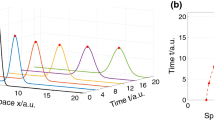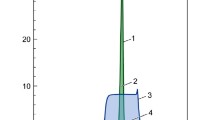Abstract
Influence of certain experimental factors and methods of data processing on the correctness of the resultant kinetics is considered on the basis of dynamic model of differential scanning calorimeter, DSC. Firstly, essential effect of sample temperature deviation from linearity or from constant outer temperature due to heat accumulation in the sample on reaction proceeding is discussed. Disregard of this effect may and will be one of the reasons of obtaining the inadequate kinetics. The method for calculation of sample temperature deviation (reconstructing sample temperature) is proposed. Secondly, influence of a DSC curve distortion due to thermal inertia of the cell on the results of kinetic analysis is considered. The method for correction of this distortion (data deconvolution) is presented which can be safely used for processing of data of kinetic experiments. Special attention is paid to the importance of data deconvolution when the kinetic experiment is carried out under isoperibolic conditions. Finally, the combined effect of temperature deviation and inertia-induced distortions is considered. It should be emphasized that the matters considered are especially important when energetic materials are tested due to big heat release and rate of heat generation. At first, all the matters are discussed on the basis of simulated data. This allows elimination of various uncertainties of real experiment and influence of unknown kinetic model and gives vivid illustration of the subject. Then, the effects are demonstrated on the basis of real experimental data. Both the model-free and model-based kinetics evaluation methods were used. The simple method is proposed which allows vivid cross-verification of both these types of kinetics.










Similar content being viewed by others
References
Wendlandt W. Thermal methods of analysis. Geneva: Interscience Publishers; 1964.
Höhne G, Hemminger W, Flammersheim H. Differential scanning calorimetry. 2nd ed. Berlin: Springer; 2003.
Calvet E, Prat H. Recent progress in microcalorimetry. Oxford: Pergamon Press; 1963.
Šesták J. Thermal analysis: thermophysical properties of solids: their measurements and theoretical thermal analysis. New York-London-Amsterdam: Elsevier; 1984.
Gray AP. A simple generalized theory for the analysis of dynamic thermal measurement. In: Porter RS, Johnson JF, editors. Analytical calorimetry. Boston: Springer; 1968. p. 209–18.
Svoboda R, Málek J. Importance of proper baseline identification for the subsequent kinetic analysis of derivative kinetic data, Part 1. J Therm Anal Calorim. 2016;24(N3):1717–25.
Svoboda R. Importance of proper baseline identification for the subsequent kinetic analysis of derivative kinetic data, Part 2. J Therm Anal Calorim. 2018;131(N2):1889–97.
Šesták J, Holba P. Heat inertia and temperature gradient in the treatment of DTA peaks: existing on every occasion of real measurements but until now omitted. J Thermal Anal Calorim. 2013;113:1633–43.
Holba P, Sestak J. The role of heat transfer and analysis ensuing heat inertia in thermal measurements and its impact to nonisothermal kinetics. In: Šesták J, Hubík P, Mareš J, editors. Thermal physics and thermal analysis from macro to micro, highlighting thermodynamics, kinetics and nanomaterials, Cham: Springer; 2017. p. 319–44.
Šesták J, Holba P. Imperfections of Kissinger evaluation method and the explanation of crystallization kinetics of glasses and melts. In: Šesták J, Hubík P, Mareš J, editors. Thermal physics and thermal analysis. Hot topics in thermal analysis and calorimetry, vol. 11. Cham: Springer; 2017.
Cesari E, Ortin J, Pascual P, Torra V, Viñals J, Macqueron JL, Dubes JP, Tachoire H. Thermogenesis: harmonic analysis and universal transference function. Thermochim Acta. 1981;48(N3):367–74.
Ortin J, Torra V, Viñals J, Cesari E. Thermogenesis: identification by means of pade approximants. Thermochim Acta. 1983;70(1–3):113–22.
Tachoire H, Torra V. Thermokinetics by heat-conduction calorimetry. Thermoc Acta. 1987;110:171–81.
Saito Y, Saita K, Atake T. Theoretical analysis of heat-flux differential scanning calorimetry based on a general model. Thermochim Acta. 1986;99:299–307.
Benin A, Kossoy A, Belokhvostov V. Data deconvolution in study of chemical reaction kinetics by DSC. J Phys Chem. 1987;LXI(5):1121–205.
Benin AI, Kossoy AA, Smikalov PYu. Automated system of kinetic research in thermal analysis. I. General description of automated system. J Therm Anal Calorim. 1992;38(5):1151–65.
Toda A, Hikosaka M. Full deconvolution of the instrumental coefficients in scanning calorimeter of heat flux type. Thermochim Acta. 2005;436:15–25.
De Rivera MR, Socorro F. Signal processing and uncertainty in an isothermal titration calorimeter. J Therm Anal Calorim. 2007;88:745–50.
Jesús C, Socorro F, De Rivera MR. New approach to Tian’s equation applied to heat conduction and liquid injection calorimeters. J Therm Anal Calorim. 2012;110:1523–32.
Pananakis D, Abel EW. A comparison of methods for the deconvolution of isothermal DSC data. Thermochim. Acta. 1998;315:107–19.
Kossoy A, Misharev P, Belochvostov V. Peculiarities of calorimetric data processing for kinetics evaluation in reaction hazard assessment. In: Proceedings of 53rd annual calorimetry conference, Midland, Michigan, USA, 1998. https://www.researchgate.net/publication/305392402. Accessed 9 Aug 2019.
Belokhvostov V, Kossoy A, Suvorov A. Methodical aspects of investigation of reactive hazards of energetic substances by applying mathematical simulation. In: Petrov Yu, editor. Physical-chemical aspects of research in the field of extreme states of materials, structures and continuous media. Saint-Petersburg: Polytechnika; 2017. p. 182–97 (in Russian).
Šesták J. Ignoring heat inertia impairs accuracy of determination of activation energy in thermal analysis. Int J Chem Kinet. 2019;51:74–80.
Šesták J. Are nonisothermal kinetics fearing historical Newton’s cooling law, or are just afraid of inbuilt complications due to undesirable thermal inertia? J Therm Anal Calorim. 2018;134:1385–93.
Barale S, Vincent L, Sauder G, Sbirrazzuoli N. Deconvolution of calorimeter response from electrical signals for extracting kinetic data. Thermochim. Acta. 2015;615:30–7.
Wadsö L. Temperature changes within samples in heat conduction calorimeters. Thermochim. Acta. 2001;366:121–7.
Albright G, Farid M, Al-Hallaj S. Development of a model for compensating the influence of temperature gradients within the sample on DSC-results on phase change materials. J Therm Anal Calorim. 2010;101:1155–60.
Vyazovkin S. Evaluation of activation energy of thermally stimulated solid-state reactions under arbitrary variation of temperature. J Comput Chem. 1997;18(N3):393–402.
Simon P. Isoconversional methods—Fundamentals, meaning and application. J Therm Anal Calorim. 2004;76:123–32.
Vyazovkin S. Isoconversional kinetics, Chapter 13. In: Brown ME, Gallagher PK, editors. Handbook of thermal analysis and calorimetry,vol. 5: recent advances, techniques and applications. Amsterdam: Elsevier; 2008. p. 503–38.
Kossoy A, Akhmetshin Y. Identification of kinetic models for the assessment of reaction hazards. Process Saf Prog. 2007;26(3):209–20.
CISP Ltd official site. http://www.cisp.spb.ru. Accessed 31 July 2019.
Acknowledgements
The assistance of the author’s colleagues V. Belokhvostov, O. Kamskaya, and A. Suvorov in conducting experiments and data analysis and fruitful discussions with them is greatly appreciated.
Author information
Authors and Affiliations
Corresponding author
Additional information
Publisher's Note
Springer Nature remains neutral with regard to jurisdictional claims in published maps and institutional affiliations.
Rights and permissions
About this article
Cite this article
Kossoy, A. Effect of thermal inertia-induced distortions of DSC data on the correctness of the kinetics evaluated. J Therm Anal Calorim 143, 599–608 (2021). https://doi.org/10.1007/s10973-019-09219-z
Received:
Accepted:
Published:
Issue Date:
DOI: https://doi.org/10.1007/s10973-019-09219-z




